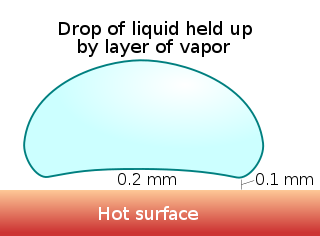
The Leidenfrost effect is a phenomenon in which a liquid, in near contact with a mass significantly hotter than the liquid's boiling point, produces an insulating vapor layer which keeps that liquid from boiling rapidly. This is most commonly seen when cooking; one sprinkles drops of water in a skillet to gauge its temperature—if the skillet's temperature is at or above the Leidenfrost point, the water skitters across the metal and takes longer to evaporate than it would in a skillet that is above boiling temperature, but below the temperature of the Leidenfrost point. The effect is also responsible for the ability of liquid nitrogen to skitter across floors. It has also been used in some potentially dangerous demonstrations, such as dipping a wet finger in molten lead or blowing out a mouthful of liquid nitrogen, both enacted without injury to the demonstrator. The latter is potentially lethal.
It is named after Johann Gottlob Leidenfrost, who discussed it in A Tract About Some Qualities of Common Water in 1756.



No comments:
Post a Comment